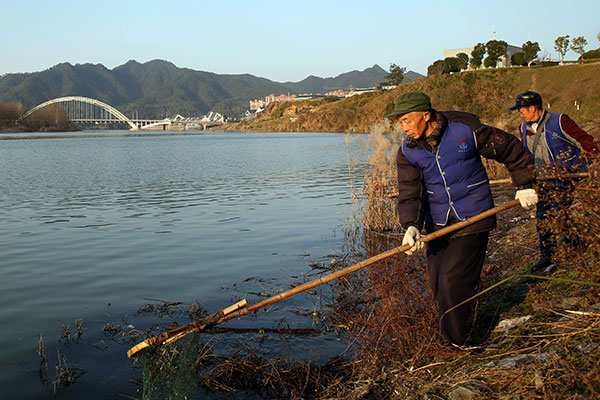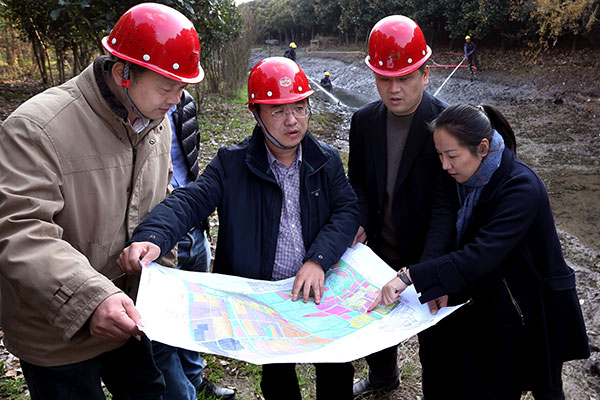
Workers remove rubbish from the Xiuhe River near the center of Xiushui, a county in East China’s Jiangxi province. In December, the central government released a document ordering the river chief system, which is linked to performance evaluations of top officials, to be established nationwide by the end of 2018.[Photo by Hou Liqiang/China Daily]
In November, when Wu Zhiguo, secretary-general of the Xiushui County Winter Swimming Association in Jiangxi province, and his fellow members discovered that slaughterhouse waste was being dumped in the Xiuhe River, where they usually swim, they reported the matter to the local authorities.
Although they didn’t expect several government departments to respond immediately, that’s what happened; the waste was quickly cleaned up and the owner of the slaughterhouse was detained and fined.
Wu said the water quality in the river has improved a lot, compared with the first half of last year.
“There isn’t that much waste in the river now because the government responded to the problem quickly,” he said.
The change happened at the end of 2015, after Jiangxi established the river chief system, which requires officials at every level of government to take full responsibility for the protection of rivers and lakes in regions under their jurisdiction.
In December, the central government released a document ordering the system, which is linked to the performance evaluations of top officials, to be established nationwide by the end of 2018.
The first national water resources survey, carried out from 2011 to 2013, showed that China has 45,203 rivers, each of which has a drainage area of more than 50 square kilometers, and 2,865 lakes whose average surface area in normal years is at least 1 sq km.
Integrated resources
Kuang Sailin, director of the Xiushui county animal husbandry and fisheries bureau, said the system integrates resources well and has helped to solve thorny problems.
To prevent pollution, livestock farms are prohibited in a radius of 1 km from the Xiuhe River and 500 meters from a tributary in Xiushui.

A group of river chiefs in East China’s Shanghai inspect a water system to prevent pollution and improve the quality of the water.[Photo/Xinhua]
However, some of the farms were built before the regulation was enacted and a large amount of compensation had to be paid to close or move them, Kuang said.
“Without the river chief system, my department could never have closed or moved those farms because we don’t have the money to pay compensation,” he said.
“Under the system, the county head is the river chief, and he’s in a position to mobilize almost all the county’s resources.”
Six livestock farms, one of which bred 100,000 pigs every year, were closed, while many others installed new sewage-disposal facilities. The county government paid compensation to those affected, he said.
The central government’s document required a bureau to be established for river chiefs at or above county level. The bureau is responsible for specific river protection efforts and also for implementing the river chief’s decisions.
All government departments and institutions are required to cooperate with the bureau to carry out protection work, based on their responsibilities.
If the system had not been implemented, there was a high possibility that some problems related to the protection of bodies of water would be shelved if the project required a coordinated approach from a number of departments, according to Luo Xiaoyun, head of Jiangxi’s Water Resources Department and also director of the provincial river chief’s office.
“We could all see the pollution in the water, but the sources were often located elsewhere, which made them the responsibility of various departments, including water resources, environmental protection, agriculture and transportation,” he said.
However, many responsibilities overlapped, and the lack of coordination between departments, and the people in charge of rivers and different sections of the same rivers resulted in management loopholes.
“Before, officials could turn to departmental heads for help when they encountered obstacles to coordination. The departments may have been overseen by different officials and the obstacles may have lain in various fields and industries. Problems may also have been shelved during the coordinating process,” he said.
With the system in place, all the problems can be solved under the leadership of top officials acting as river chiefs. Joint conferences are held when the responsibilities of different departments overlap and are the cause of unresolved problems. If a consensus is reached, the river chief’s office will notify all departments to take action as agreed; if not, the river chief, or even the general river chief, will have to make a decision, which they must implement.
Leng Fenhua, river chief of the Wulingshui River in Xiushui, said the system has put him in a better position to seek cooperation from departments he doesn’t control.
As the vice-mayor of Xiushui, Leng oversees departments related to agriculture, hydrology, and water and soil conservation, and he is often involved in river protection issues.
Improved efficiency
“Before the system was established, it was easy to coordinate the departments I oversaw when we needed to take action to protect the river, but that wasn’t the case when I needed to coordinate departments I didn’t oversee. For example, it was beyond my authority to order environmental and construction departments to take action,” he said.
According to Leng, more than 20 government departments are members of a leading group at the river chief’s bureau, so the new system allows their activities to be coordinated.
The system helps to tackle tough challenges, Zhang Bo, director of the Department of Water Environment management at the Ministry of Environmental Protection, said during a media briefing about the river chief system in December.
China’s unbalanced industrial structure has hindered the prevention and control of water pollution in many regions, and local governments face a choice between developing the economy or protecting the environment, he said.
With top officials now accountable as river chiefs, the system will help to change the nation’s industrial structure and better protect the environment, he said.
